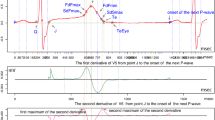Abstract
Measurements of the Q-T interval are less reliable in children than in adults. Identification of superior diagnostic tools is warranted. This study aimed to investigate whether a vectorcardiogram (VCG) recorded from three orthogonal leads (X, Y, Z) according to Frank is superior to a 12-lead electrocardiogram (ECG) in providing a correct long Q-T syndrome (LQTS) diagnosis in children. This LQTS group consisted of 35 genetically confirmed carriers of mutations in the KCNQ1 (n = 29) and KCNH2 (n = 6) genes. The control group consisted of 35 age- and gender-matched healthy children. The mean age was 7 years in the LQTS group and 6.7 years in the control group (range, 0.5–16 years). The corrected Q-T interval (QTc) was measured manually (QTman) by one author (A.W.). The 12-lead ECG automatic measurements (QTECG) and interpretation (QTInterpret) of QTc were performed with the Mac5000 (GE Medical System), and the VCG automatic measurements (QTVCG) were performed with the Mida1000, CoroNet (Ortivus AB, Sweden). By either method, a QTc longer than 440 ms was considered prolonged and indicative of LQTS. Of the 35 children with genetically confirmed LQTS, 30 (86 %) received a correct diagnosis using QTVCG, 29 (82 %) using QTman, 24 (69 %) using QTECG, and 17 (49 %) using QTInterpret. Specificity was 0.80 for QTVCG, 0.83 for QTman, 0.77 for QTECG, and 0.83 for QTInterpret. The VCG automatic measurement of QTc seems to be a better predictor of LQTS than automatic measurement and interpretation of 12-lead ECG.
Similar content being viewed by others
References
Arvedsson O (1986) Methods for data aquisition and evaluation of electrogram and vectorcardiograms with digital computer. Dissertation, University of Umeå, Sweden
Bazett HC (1920) An analysis of the time-relation of electrocardiograms. Heart 7:353–370
Brohet CR (1990) Special value of the vectorcardiogram in pediatric cardiology. J Electrocardiol 23(Suppl):58–62
Diamant UB, Winbo A, Stattin EL, Rydberg A, Kesek M, Jensen SM (2010) Two automatic QT algorithms compared with manual measurement in identification of long QT syndrome. J Electrocardiol 43:25–30
Frank E (1956) An accurate, clinically practical system for spatial vectorcardiography. Circulation 13:737–749
GE Healthcare (2007) Marquette 12SL, ECG Analysis Program Physician’s Guide [416791-004]
Goldenberg I, Moss AJ (2008) Long Q-T syndrome. J Am Coll Cardiol 51:2291–2300
Goldenberg I, Moss AJ, Zareba W (2006) Q-T interval: how to measure it and what is “normal”. J Cardiovasc Electrophysiol 17:333–336
Miller MD, Porter C, Ackerman MJ (2001) Diagnostic accuracy of screening electrocardiograms in long Q-T syndrome I. Pediatrics 108:8–12
Murray A, McLaughlin NB, Bourke JP, Doig JC, Furniss SS, Campbell RW (1994) Errors in manual measurement of Q-T intervals. Br Heart J 71:386–390
Perry LW, Pipberger HV, Pipberger HA, McManus CD, Scott LP III (1986) Scalar, planar, and spatial measurements of the Frank vectorcardiogram in normal infants and children. Am Heart J 111:721–730
Restier-Miron L, Fayn J, Millat G, Denjoy I, Rodriguez-Lafrasse C, Rubel P, Chevalier P (2007) Spatiotemporal electrocardiographic characterization of ventricular depolarization and repolarization abnormalities in long Q-T syndrome. J Electrocardiol 40:368–374
Schwartz PJ, Moss AJ, Vincent GM, Crampton RS (1993) Diagnostic criteria for the long Q-T syndrome: an update. Circulation 88:782–784
Sederholm ML, Erhardt L, Sjögren A (1983) Continuous vectorcardiography in acute myocardial infarction: natural course of ST and QRS vectors. Int J Cardiol 4:53–63
Zareba WF, Badilini F, Moss AJ (1994) Automatic detection of spatial and dynamic heterogeneity of repolarization. J Electrocardiol 27(Suppl):66–72
Acknowledgments
The Swedish Heart-Lung Foundation, the Northern County Councils Cooperation Committee, and the Heart Foundation of Northern Sweden provided financial support for this research.
Author information
Authors and Affiliations
Corresponding author
Rights and permissions
About this article
Cite this article
Diamant, UB., Jensen, S.M., Winbo, A. et al. Vectorcardiographic Recordings of the Q-T Interval in a Pediatric Long Q-T Syndrome Population. Pediatr Cardiol 34, 245–249 (2013). https://doi.org/10.1007/s00246-012-0425-2
Received:
Accepted:
Published:
Issue Date:
DOI: https://doi.org/10.1007/s00246-012-0425-2




